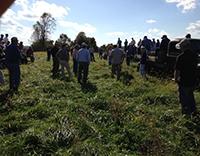Pasture Walk: Big Spring Farm
 Greg Brann, owner and operator of Big Spring Farm, held a pasture walk on October 17, 2014, at his farming operation in Adolphus, Kentucky, which is located on the Kentucky/Tennessee border. Around 120 people from Kentucky, Indiana, and Tennessee were in attendance at this event. His operation is 320 pasture acres and he has a diversified herd of 55 beef cows, 275 sheep, and 2 donkeys. He has several additional acres in the CREP program to help protect the streams, wildlife and prevent erosion.
Greg Brann, owner and operator of Big Spring Farm, held a pasture walk on October 17, 2014, at his farming operation in Adolphus, Kentucky, which is located on the Kentucky/Tennessee border. Around 120 people from Kentucky, Indiana, and Tennessee were in attendance at this event. His operation is 320 pasture acres and he has a diversified herd of 55 beef cows, 275 sheep, and 2 donkeys. He has several additional acres in the CREP program to help protect the streams, wildlife and prevent erosion.
Greg practices managed grazing and said he manages each pasture depending on types of forages in the pasture. In recent years, the stocking rate has decreased on his land due to culling rates and weather conditions. He has 16 permanent pastures, and with the use of temporary fence, these are split into over 100 paddocks. Watering locations, which are available in each paddock, are often moved to promote more targeted grazing in areas of a paddock which are being underutilized. The herd is usually moved every 3 days depending on forage availability and weather conditions, and paddocks are given around a 40-60 day rest period. Typically the grazing height is maintained at 4” or higher.
Greg told the group that he had been feeding hay for a couple weeks, and that he has overcome the mindset of waiting to feed hay in the winter when his forages are depleted. He said that he would rather feed hay now to give his forages a rest, allowing them to regrow, and then graze them again during the winter months. He says that the quality of stockpiled grass is higher than most of the hay he has, and is less expensive than buying hay.
Greg uses many different forage species including many cool-season grasses and warm-season species that are strategically seeded for grazing and land management. He likes to keep his forage program diversified because it helps reduce his risk of not having pasture if one forage happens to be unsuccessful. The cool-season forages that are a part of his grazing program include orchardgrass, tall fescue, Kentucky bluegrass, bermudagrass, bromegrass, ryegrass, red clover, white clover, and many native species. Some of the other forages include turnips, radishes, wheat, and buckwheat. Greg had some johnsongrass which he manages as part of his grazing forage species. He really emphasized not having any bare ground, and having some type of forage covering each spot in his pastures.
No chemical fertilizer, besides lime, is applied to pastures. Forages on his farm are only harvested by grazing. Greg buys the majority of his hay from outside sources because he does not like to take the nutrients off of his land. He would rather have the animals graze that forage and deposit manure and urine back on the field, putting nutrients back into the soil. Fertility is monitored by taking soil tests every year and applying lime as needed. He likes to keep soil pH levels at 6.2 or higher. He said he can graze his animals on a paddock for an hour or two, then move them to another paddock where they will defecate and urinate, depositing the nutrients taken from the previous field into the new one. He said this way he can improve soil conditions in pastures with inadequate nutrient levels.
Greg explained how multispecies grazing has increased his production, reduced his forage stress load, and has provided other benefits to his land and operation. Grazing sheep and cattle together allows for a larger use of forages as each species is unique in how they graze and what they select. This practice also contributes to weed control as the small ruminants prefer to graze weedy forbs. The reasoning for grazing one large, mixed herd also includes: longer rest periods for pastures (reduces internal parasite load that can be harmful to the sheep), one stop for feeding guard dogs, one stop for feeding hay, more power on less fence, less fence to check, and a higher stocking density for a shorter period of time.
Greg is always looking at ways to improve his operation and is not scared of change. He told the group he has to keep an open mind in order to be profitable. Greg is very attentive to the forage quality that his animals have access to and said that if they are not at the level he is satisfied with he will add grain to their diet in order to keep weight gains consistent throughout the year. He evaluates the impact and improvements to management every time he enters a pasture and determines what is needed to improve the economics, environment, and dynamics of his operation. Working the land is fun and rewarding to Greg, and he is devoted to making his operation profitable while protecting the environment.
Categories:
General
Farm Highlights


